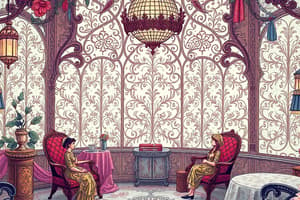Podcast
Questions and Answers
What is the correct sentence structure for the affirmative form in the present simple?
What is the correct sentence structure for the affirmative form in the present simple?
- Subject + Verb (past simple) + Object/Complement
- Subject + Verb (present perfect) + Object/Complement
- Subject + Verb (base form) + Object/Complement (correct)
- Subject + Verb (future simple) + Object/Complement
What do you add to the verb for the third person singular in the present simple?
What do you add to the verb for the third person singular in the present simple?
- nothing
- -ed
- -ing
- -s or -es (correct)
What is one of the ways the present simple is used in daily life?
What is one of the ways the present simple is used in daily life?
- To describe past experiences
- To describe habits and routines (correct)
- To describe completed actions
- To describe future plans
What is another way the present simple is used in daily life?
What is another way the present simple is used in daily life?
What is one of the areas where the present simple is often used?
What is one of the areas where the present simple is often used?
What is another area where the present simple is often used?
What is another area where the present simple is often used?
What is an example of a universal truth that uses the present simple?
What is an example of a universal truth that uses the present simple?
What do you open wide when a doctor examines your throat?
What do you open wide when a doctor examines your throat?
What are separate parts of your foot?
What are separate parts of your foot?
What is fixed to your shoulder and has hands at the end?
What is fixed to your shoulder and has hands at the end?
What do you need to stand or walk?
What do you need to stand or walk?
What can be long, short, curly, straight, dark or fair?
What can be long, short, curly, straight, dark or fair?
Flashcards are hidden until you start studying
Study Notes
Sentence Structure
- The present simple sentence structure is as follows:
- Affirmative: Subject + Verb (base form) + Object/Complement
- Negative: Subject + does not/do not + Verb (base form) + Object/Complement
- Interrogative: Does + Subject + Verb (base form) + Object/Complement?
- For third person singular (he, she, it), add -s or -es to the verb:
- He/She/It + Verb (base form + -s/-es) + Object/Complement
Usage in Daily Life
- The present simple is used to describe:
- Habits and routines: I get up at 7:00 am every day.
- General truths and facts: The sun rises in the east.
- Scheduled events: The bus arrives at 8:00 am.
- Fixed arrangements: I have a meeting at 2:00 pm today.
- Preferences and likes: I love reading books.
- Permanent situations: I live in New York.
- The present simple is also used to talk about:
- Universal truths: Water boils at 100°C.
- Scientific facts: The earth orbits around the sun.
- Timetables and schedules: The train leaves at 5:00 pm.
- News headlines: The company announces a new product.
- The present simple is often used in:
- Descriptions of people, places, and things
- Instructions and recipes
- News and reports
- Scientific and academic writing
Sentence Structure
- The present simple sentence structure follows a specific pattern:
- Affirmative: Subject + Verb (base form) + Object/Complement
- Negative: Subject + does not/do not + Verb (base form) + Object/Complement
- Interrogative: Does + Subject + Verb (base form) + Object/Complement
- For third person singular (he, she, it), add -s or -es to the verb:
- He/She/It + Verb (base form + -s/-es) + Object/Complement
Usage in Daily Life
- The present simple is used to describe:
- Habits and routines
- General truths and facts
- Scheduled events
- Fixed arrangements
- Preferences and likes
- Permanent situations
- The present simple is also used to talk about:
- Universal truths
- Scientific facts
- Timetables and schedules
- News headlines
- The present simple is often used in:
- Descriptions of people, places, and things
- Instructions and recipes
- News and reports
- Scientific and academic writing
Human Body Parts
- A doctor examines the throat by opening the mouth wide.
- The toes are separate parts of the foot.
- The arm is fixed to the shoulder and has hands at the end.
- The legs are essential for standing or walking.
- The eyes are necessary for seeing.
- The hands are used for touching, holding, and catching things.
- Hair can be long, short, curly, straight, dark, or fair.
- The ears are needed to hear sounds.
- The nose is necessary for breathing and smelling.
Studying That Suits You
Use AI to generate personalized quizzes and flashcards to suit your learning preferences.




